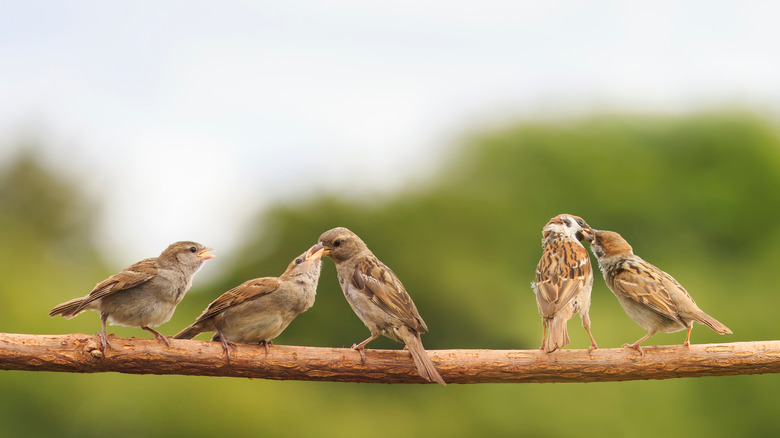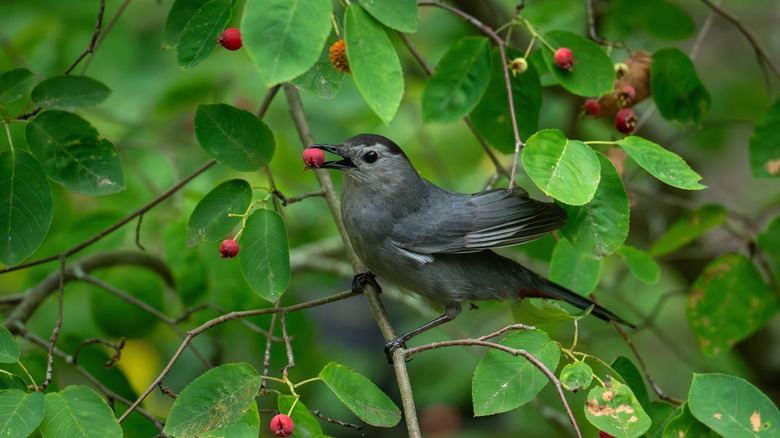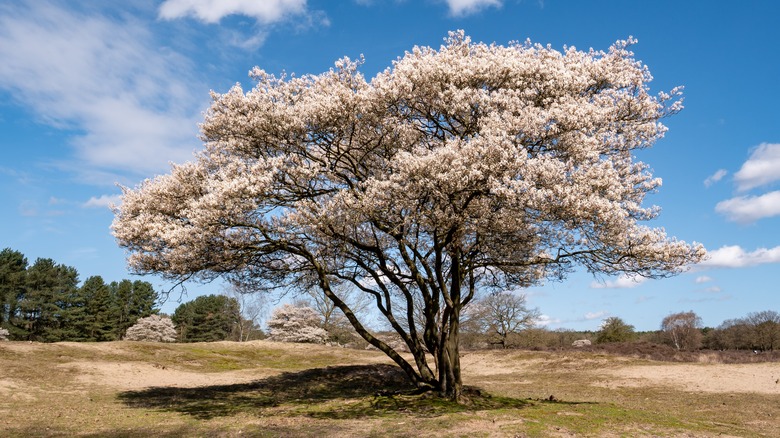Bring More Birds To Your Yard With This Stunning Fruit-Bearing Tree
Intentionally attracting more songbirds to your yard can bring joy and wonder to your outdoor living space. However, happiness and mental stimulation aren't all these flying creatures have to offer. Birds can bring real ecological benefits to your yard with them as well, including seed dispersal, pollination, and pest prevention and control. If you're ready to attract more birds to your yard for any or all of these reasons, planting a serviceberry tree — also known as a juneberry tree — is a great way to start.
This gorgeous tree doesn't only attract birds with its sweet and nutritionally dense berries. It also produces small elegant white flowers that bring in insects, which then attract the birds that hunt and eat those insects, making it a powerhouse for bird attraction. The tree's berries alone are known to draw in over 35 species of bird. Consider this your guide to utilizing a serviceberry tree to bring more beneficial birds into your outdoor living space.
Serviceberry trees and birds: A love story
There are many trees that can help attract birds to your yard, so why choose a serviceberry tree? These trees offer a doubly attractive appeal to birds thanks to their showy white flowers — which are beloved by many insects — and their sweet, nutritious berries. This means that it won't only attract birds when its berries appear or reach peak ripeness in June and July; the flowers that appear in spring will start to attract insects that will, in turn, lure birds as early as April. Just keep in mind that your new tree won't bear fruit for the first 2 to 4 years.
As for which types of birds you can expect to see on your juneberry tree, there are many possibilities, and they will differ a bit depending on your location. Generally speaking, some of the bird species that enjoy visiting serviceberry trees include Baltimore orioles, robins, and mockingbirds. Looking to boost your yard's bird population even more? Try making a DIY bird feeder to hang in your juneberry tree or plant other fruit and berry trees that birds love nearby.
Planting and caring for your serviceberry tree
Serviceberry trees are low-maintenance fruit-bearing trees that are easy to care for. These trees prefer full sun exposure but will tolerate partially shady conditions. They also require soil that is moist but well-draining. If your soil is particularly wet, it may be beneficial to add some organic matter, like shredded leaves or shale, as a simple amendment that will improve the heavy clay soil. Plant your sapling with its uncovered root ball level with the soil surface. Deeply water your new serviceberry sapling and prepare to watch it grow into a safe haven for birds in your yard.
Covering the tree's root ball area with mulch can help increase its eventual yield of bird-attracting berries by preventing the growth of competitive weeds at its base. Fertilizer is not typically necessary for serviceberry trees to thrive in average soil. However, if you know that your soil is lacking in nutrients, you may apply a general-purpose fertilizer each spring. Aggressive pruning is also unnecessary for serviceberry trees to survive and should be especially avoided during the first three years of their lives. During this period, only dead, diseased, or damaged branches should be removed. After the third year, more vigorous pruning for size and shape, as well as a boost in fruit production, is recommended.


